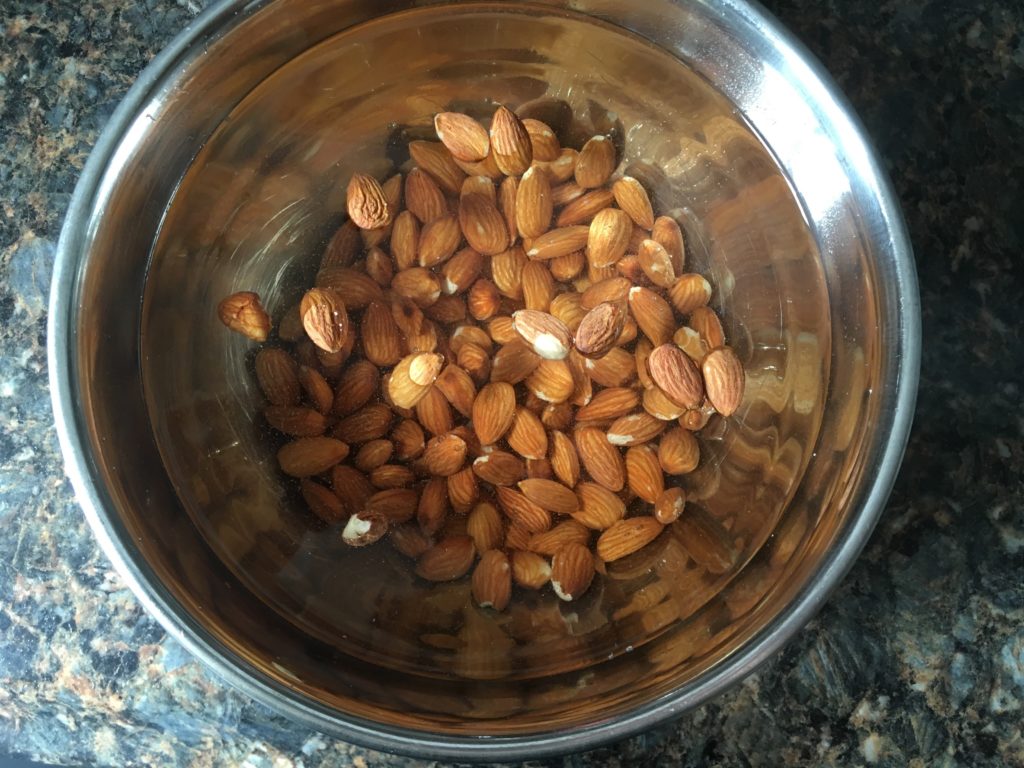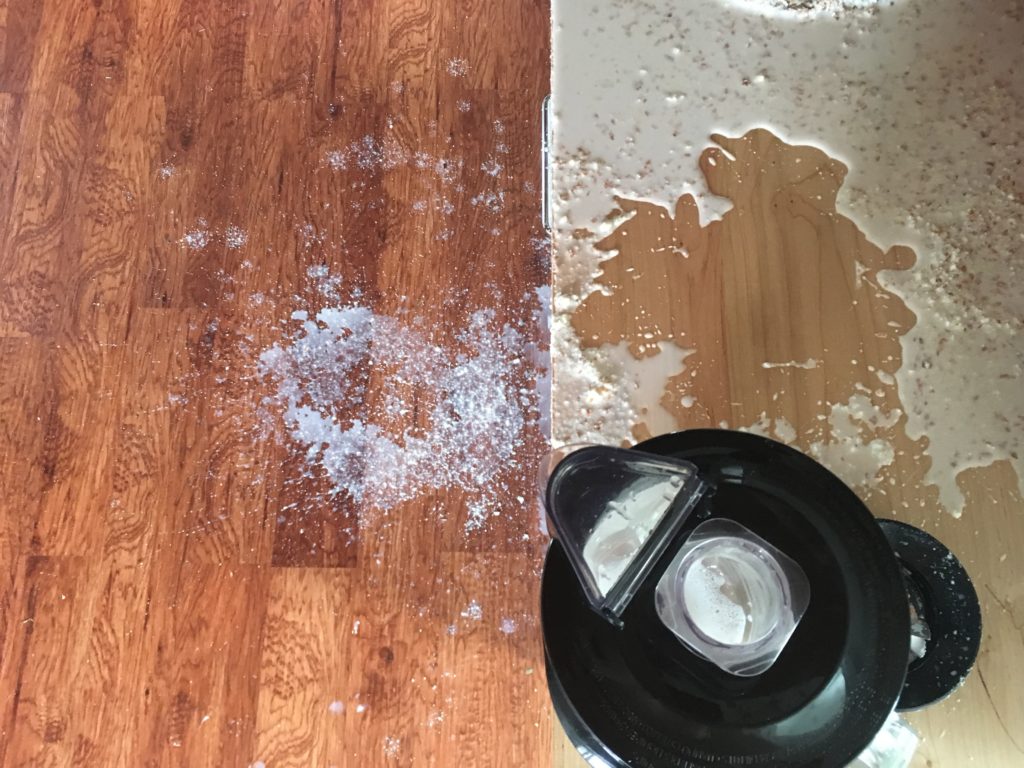I tried to make almond milk from scratch. Here’s how it went.

I have more experience with plant-based milks than your average non-vegan consumer. During my six-month fellowship at the California-based “Sierra Magazine” before I moved to Maine, I spent one sunny afternoon sampling an array of eight non-dairy milks and writing about it, weighing the products’ purported eco-bonafides against their taste.
It was one of the most popular articles I wrote during my tenure, but it took the rest of my time on the West Coast for my gastrointestinal system to recover. These “milks” are made for the lactose-intolerant, sure, but you are definitely not supposed to drink them all at once.
Now, I rarely use plant-based milks in my daily life. I drink my coffee black. I only buy milk for baking or making mac’n’cheese. For me, the products are so hit or miss, and I usually cannot justify the added cost of the ones that I like.
I may be an outlier in this respect. Since 2012, non-dairy milk sales have increased by 61 percent. Because of the impact on the ever-declining dairy industry, its advocates have even lobbied for laws that make it illegal to call plant-based milks “milk” at all.
Of the various options — and, trust me, there are many — almond milk reigns supreme, dominating 64 percent of the plant-based milk market. Sales of almond milk alone shot up 250 percent between 2011 and 2016.
Part of the shift to plant-based “milks” (“juices” could be a dairy-neutral alternative, but it sounds a little clinical) may come from a growing environmental consciousness. According to a study out of the University of Oxford, the greenhouse gas emissions associated with producing a glass of dairy milk are about three times greater than any plant-based alternative. Globally, the dairy sector emits 4 percent of all human-caused emissions. Most of this is in the form of methane, a potent greenhouse gas released by cow burps (their farts are, apparently, less problematic).
Almond milk is not a magic elixir, though. It takes over a gallon of water to produce a single almond. California, which produces 80 percent of the world’s almonds, dedicates one-tenth of its water resources (which are limited and dwindling) to almond production. Growing almonds also requires 60 percent of the nation’s managed honeybees for pollination at one time, the sheer density of which increases the risk of disease and colony collapse.
Making your own almond milk may not reduce such environmental ills on the West Coast, but it does have its advantages. Almond milk is often sold in foil-lined packages, which are light and do not require refrigeration during shipping, but are also difficult to recycle. Store-bought almond milk also often contains unhealthy sweeteners and shelf stabilizers. To improve its viscosity, some almond milk manufacturers even bolster their brews with carrageenan, a seaweed derivative that may cause digestive problems.
Even though I prefer other types of plant-based milks (long live oat milk and macadamia nut milk), almond milk is, apparently, one of the easiest planted-based milks to make. Despite my stomach’s past trauma, I decided to give it a shot.
Learning to try
First, I chose this recipe from Downshiftology. It seemed straightforward: almonds and water, plus a little sweetener and salt for flavor. The ingredients were easy to gather, but I had to buy a new blender. Ironically, I left my trusty old Black+Decker blender in California when I moved last year.
In my research, I read that almond milk production leaves behind piles of pulp. Though some almond milk producers claim to repurpose the waste as much as possible, I could not find definitive information about what, exactly, is done with the pulp. I assume much of it is disposed of or composted — apparently, almond pulp makes for great compost material — but I wanted to be more creative.
Chefs around the country have struggled to find the best way to use the gritty, flavorless pulp, but I was undeterred. I prepared to use this recipe for almond pulp cookies from Elana’s Pantry.
I also read that almond pulp makes an excellent exfoliant and body scrub. As a millennial, I have been fully indoctrinated into the philosophy that skin care is self-care, so I couldn’t resist. I lined up this DIY almond pulp body scrub from The Blender Girl. I figured I could try both and give my informed opinion about which method for repurposing almond pulp I thought was best.

A trying experience
The almond milk recipe first called for a cup of almonds to soak overnight. After I prepared my soaking bowl, I watched a few oblong nuts bob to the top. It seemed like an awful waste of a good snack, but I forged ahead.
The next day, I blended the damp almonds with four cups of water, a little sweetener and salt. That’s right: four cups of water for one cup of almonds. No wonder dairy producers are so up-in-arms about plant-based milks — they’re mostly water! Still, I was surprised how quickly the mixture took on a milky texture and color in the blender.
Then, disaster struck.
I was not accustomed to the machinations of my new blender and, apparently, I failed to properly attach the bottom. When I lifted the glass off of the base, I noticed cloudy drops of liquid pooling on the countertop. Something was clearly wrong. I couldn’t identify the problem in the moment, but I knew there was no time to waste.
I tried to move quickly to the bowl I had set up with the cheesecloth. Before I could set the blender down, the bottom fell out, and I spilled almond milk all over my kitchen island and floor.
Thanks to my quick footing, though, I was able to save enough almond milk and pulp to continue with my experiment — albeit, with slightly less end-product than I had hoped.
Squeezing the blended almond mixture is, undoubtedly, fun. It almost seems to mimic the process of milking a cow, though I have to admit, that is not something I have ever done. Again, how millennial of me: squeezing a makeshift nut teat before I ever get my hands on an udder.

I sampled the fruits and seeds (yes, nuts are technically both fruits and seeds — mind, blown) of my labor. The almond milk by itself tasted extremely bland, but it was delicious in coffee. The subtle nuttiness brings out the most pleasant flavors of the brew while tempering the bitterness. It was almost enough to sway me from taking my morning coffee black.
A heads up: without the benefit of stabilizers and emulsifiers, homemade almond milk settles and separates. It’s still good to drink, though, and with a little shake, it looks good as new.
Now, onto the pulp: with the aid of, appropriately, some California dates, the almond pulp cookies were shockingly moist. Given that they were vegan, I honestly was not expecting much (sorry), but I ate them right up.
Baking seems like the easiest way to use almond pulp — after all, isn’t it basically damp almond flour? — so I’d be curious to try some of the more creative methods to incorporating almond pulp into home cuisine, like using it to make almond cheese or as a substitute for breadcrumbs.
The almond pulp exfoliant was wonderful. After a quick scrub with warm water, my face felt dewy, springy and radiant. Often after using store-bought exfoliants, my skin feels raw and exposed. The almond pulp scrub left it feeling creamy and clean.
My tried-and-true takeaways
Making almond milk is a blast, blender mishaps notwithstanding. I am not sure if making your own almond milk is more cost-effective than buying a store-bought brand given the price of almonds (in Maine, at least).
If you are looking to reduce waste in your kitchen, get creative with almond pulp and add an excellent new exfoliant to your skincare routine, though, it may be worth it. Just make sure you screw in the bottom of your blender before you start.



